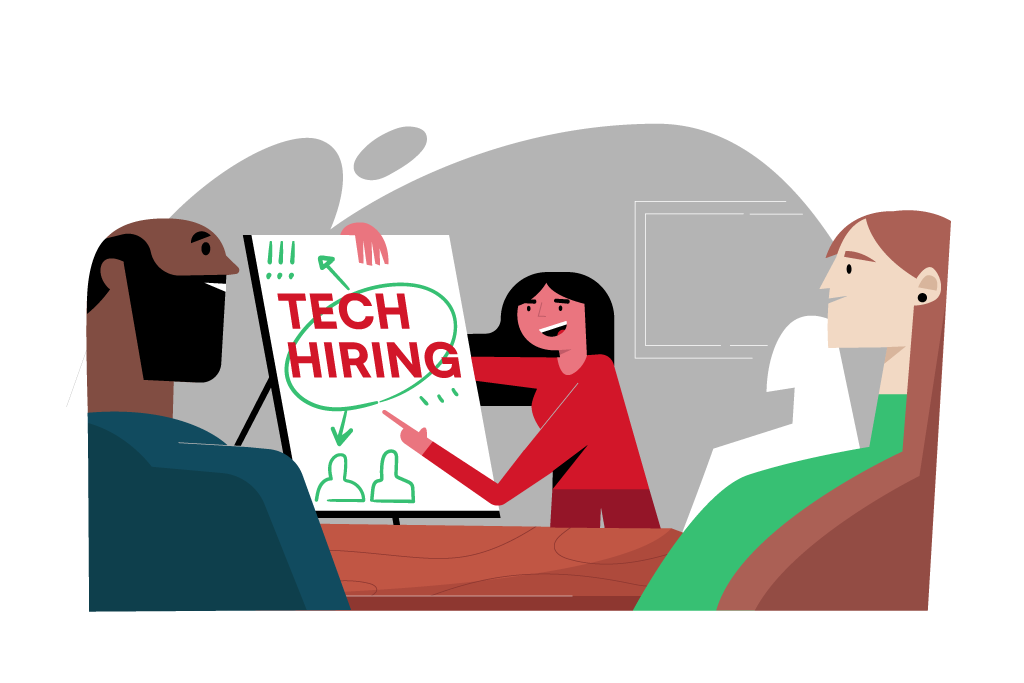How is the Interview Process Changing?

AI isn’t replacing developers—it’s just the latest in a long line of tools helping them move faster and build smarter. Think back to when API documentation became searchable, IDEs streamlined debugging, or code completion tools like IntelliSense started saving keystrokes—AI is the next evolution.
In our last article, we covered how developers are already weaving AI into their everyday workflows and why that trend isn’t slowing down anytime soon. (Spoiler: it’s not going away.)
With AI quickly becoming the norm, it’s clear: the interview process needs to catch up.
What does the interview process look like for software engineers?
Most organizations have 5 different touch points with a candidate, each representing a different stage of the interview process. This can be visualized as an interview funnel where you have a high volume of candidates at the top of the funnel, and gets smaller and smaller over time.
Typically the funnel looks something similar to the following :
- Application submission, employee referral, cold recruiter outreach.
- Talent Acquisition phone screen
- Manager phone screen
- Technical screen
- On site interview
The hiring process varies by organization, but it generally follows a structured approach to identify and hire candidates, with differences in the order and number of screening steps.
Initial Contact: Application, Referral, or Recruiter Outreach
The hiring process begins when a candidate is identified through recruiter outreach, an employee referral, or a job application submission—commonly known as the “first touch.” At this stage, the Talent Acquisition (TA) team reviews candidate backgrounds to ensure alignment with the role’s requirements. TA filters out mismatched candidates and compiles a list for the hiring manager’s review.
This process remains ongoing until the role is filled, ensuring a steady pipeline of candidates in case finalists don’t pass later interview stages or decline offers.
Outcome: A shortlist of candidates is presented to the hiring manager for review and potential progression to the next step.
Talent Acquisition Phone Screen
Candidates selected from the initial review typically participate in a phone screen with TA. This call covers role expectations, required qualifications, and company information while verifying the candidate’s relevant experience. Additionally, TA informally assesses soft skills, including communication and potential cultural fit with the team.
Outcome: TA determines if the candidate is a strong fit and, if so, advances them to the manager phone screen.
Manager Phone Screen
Candidates who pass the TA screen typically proceed to a 30-minute call with the hiring manager. This conversation dives deeper into the candidate’s background, technical expertise, and how their experience aligns with the team’s needs. Like the TA screen, this stage also evaluates communication skills and team compatibility.
Outcome: The hiring manager selects candidates who show strong potential for success in the role and moves them forward to the technical screen.
Technical Screen
The technical screen assesses whether a candidate has the necessary skills to perform the job. Companies may use:
- Asynchronous assessments (e.g., CoderPad Screen), which include coding problems, multiple-choice questions, and design challenges.
- Synchronous live coding interviews (e.g., CoderPad Interview), where a candidate collaborates with a team member on a coding problem in real time (typically 30–45 minutes).
Outcome: Candidates who demonstrate sufficient technical ability proceed to the final on-site interview.
On-Site Interview
Candidates who clear the technical screen are invited to an on-site interview, usually a full-day process with multiple sessions:
- Three technical interviews covering real-world problem-solving relevant to the job.
- A product-focused discussion with the product team to assess collaboration skills.
- A hiring manager interview focused on soft skills, leadership potential, and overall fit.
Outcome: The company makes a final hire/no-hire decision based on performance across all interview rounds.
How to incorporate AI tools in your interview process
Before asynchronous interviews, ensure your team is aligned on whether candidates can leverage external tools, allowing you to set expectations with the candidates up front.
Do you want the candidate googling at all or using external help? If so, we also recommend giving them open access to AI tooling such as ChatGPT, CoPilot, and others.
Ideally, you’re using a tool like CoderPad Screen, which automatically detects copy/paste actions and flags unmodified or duplicated code—whether sourced externally or generated by LLMs. With this safeguard in place, you can simply inform candidates that while external tools are allowed, the system will automatically highlight any instances where they haven’t independently crafted their solution, ensuring a fair and transparent process.
For synchronous interviews, we strongly recommend embracing the reality of modern development—allowing candidates to freely use online tools like Google and ChatGPT, just as they would on the job.
However, make it clear that simply copying an answer isn’t enough. Your technical interviewers will dive deeper, challenging candidates to explain and build upon any solution or hint they find online. If a candidate can’t articulate their reasoning or expand on borrowed code, it’s a clear red flag for the hiring team.
Best Practice for Interviewing in the Age of AI
In this article, we’ve explored the fundamentals of the software engineering hiring process and how AI tools can be integrated effectively into your process at a high level. As the landscape of technical hiring evolves, embracing AI in your process isn’t just an option—it’s a necessity.
If you’re struggling with any of this, reach out to our sales team to learn how CoderPad Screen and CoderPad Interview can help streamline your interview process and leverage AI tools effectively.
But how can you design interviews that truly evaluate a candidate’s problem-solving abilities in a world where AI is a constant companion? Our upcoming third article in the series will take you on a deep dive into the “how-to” of crafting effective asynchronous and synchronous interviews, ensuring you’re hiring engineers who harness AI as a powerful asset—not a crutch. This article will provide an in-depth look at the ideal interviewing process in the age of AI. Stay tuned!